|
|||||||||||||||||||||||||||||||||||||||||||||||||||||||||||||||||||||||||||||||
Freshwater Molluscan Shells / Viviparidae
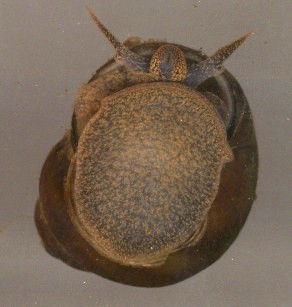
Viviparus georgianus (Lea, 1834), (left), and Campeloma limum (Anthony, 1860), (right). Campeloma has the large
foot characteristic of active snails that plow through sand just beneath the surface. Both species are native to
rivers and streams of the Southeastern United States coastal plain.
Viviparidae, commonly referred to as "mystery snails" have a worldwide distribution. Burch, (1982) list 17 total species for North America. Preston, (1915) lists fourteen for India, Liu Yueyin (1979) includes twelve for China, and Zhadin, (1952) lists five for the territory of the former USSR. They are also present in Australia, Africa and Europe (six species, see Fischer), but except as fossils, absent in South America. The viviparidae are noteworthy in their wide selection of foodstuffs. Brown (1991) indicates they can function both as grazers, consuming algae growing on any submerged surface, and detritivores, utilising fine particulate organic matter and the bacteria and other microorginisms therein. They also filter feed on suspended matter, competing with the clams and mussels. Dillon (2000) indicates that North American Campeloma can also be baited with carrion, and describes the process by which Viviparus snails consume suspended particulate material.
The gills of Viviparus are characterized by unusually large triangular lamellae whose tips hang over a ciliated gutter or "food groove" running across the floor of the mantle cavity.... Cilia ...direct mucus and entrapped particles to the food groove. Particles collected on the gill filaments are carried to the tip, where they also fall into the grove. A food/mucus string forms which is carried forward and collected into a ball or "sausage". Periodically the snail will turn its head and eat the collected food.
Principal genera, in three subfamilies:
Viviparinae;
Viviparus; Eastern North America and most of Europe.
Tulatoma; endemic in Coosa River, Alabama, USA.Campelominae or Lioplacinae;
Campeloma; Eastern North America.
Lioplax; Eastern North America.Bellamyinae;
Bellamya; Africa, India, southeast Asia.
Cipangopaludina; east and southeast Asia, and as an exotic elsewhere.
Notopala; eastern Australia.
Larina; northeast Australia.
unclassified;
Margarya; China
Angulyagra; China
Rivularia; China
Neothauma; Africa
Heterogen; Japan
Taia; Southeast Asia
Asia
Heterogen longispira
Smith, Japan.
Amuropaludia
pachya
Bourguignat,1860,
far east Russia.<- Cipangopaludina chinensis
(Reeve, 1863), now found near
Washington, DC, Southern California
lakes, and other places in the United
States and Canada. The Chinese
mystery snail is sold in traditional
Chinese markets.
Cipangopaludina japonica
(Martens, 1861), also found in the
United States, is similar, but
somewhat more high-spired and
angular.
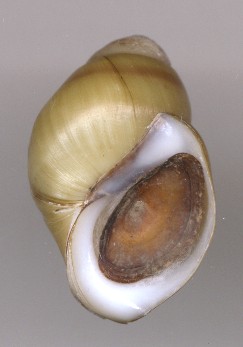
Thick shelled Chinese Rivularia snails: Rivularia auriculata von Martens, 1875
from Fujian Province, (above) and Rivularia bicarinata Kobelt, 1909 from Hunan
Province. (below).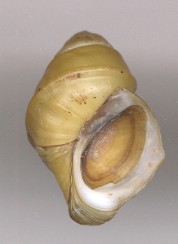
Images below from Liu Yueyin (1979)
Cipangopaludina
ussuriensis
(Heude), northern
China.
Margarya mansuyi
Deutzenberg et
Fischer, Yun Nan,
China.
Margarya melanoides
Nevill, Yun Nan region
lakes, China.
Bellamaya
purificata (Heude),
widespread, China.
probably Angulyagra
polyzonata (Frauenfeld)
Canton, China
Southeast Asia
Filopaludina sumatrensis polygramma (Martens, 1860),
Thailand
Bellamya angularis
(Muller, 1774), Philippines
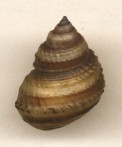
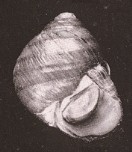
Taia elitoralis
Annadale, 1918 (left)
Anulotaia mekongensis
Brandt, 1970 (center)
Trochotaia trochoides
(Martens, 1860) (right)
Black and white images
from Brandt (1974)
Brandt (1974) lists several genera endemic to Thailand and Southeast Asia, and includes the
following numbers of species for the territory of Thailand: Filopaludina 6 species plus 4 additional
subspecies; Sinotaia 2; Annulotaia 2; Trochotaia 1; Eyriesia 1; Idopoma 3 Cipangopaludina
1; and Mekongia 6.Viviparid snails are consumed as foodstuff in several Asian countries, and have become available in Asian grocery stores elsewhere. At one location in the American mid-South, 450 gram frozen packages from Vietnam are sold for $3.99.
Europe
Please visit Wolfgang Fischer's page at http://ipp.boku.ac.at/private/wf/Europaeische_Viviparidae_main.html for images of the six recent and additional fossil European species.
Eng; Mystery snails
De; Sumpfdeckelschnecken
It; Viviparo, Paludina
Fr; PaludineNe; moerasslaken
Ru; Ц#150;ивоѦ#128;одки
[zhivarodki]
Pol; żyworódka
Viviparus mammilatus
(?) Kuster 1852,
Monte Negro
Viviparus acerosus
(Bourguignat 1862)
Hungary
Viviparus contectus Millet
ponds, Hungary
Viviparus viviparus
(Linnaeus, 1758)
Belgium, elsewhere in
Europe
Africa
Pilsbry and Bequaert, (1927) list 35 Viviparus species, with 22 additional varieties, and one species with three additional varieties for Neothauma. At least some of the Viviparus species have since been placed with Belamya.
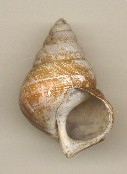
Neothauma tanganyicensis Bourguignat,
1885. Lake Tanganyika.
Specimen contributed by Gerald Depaus, Belgium.
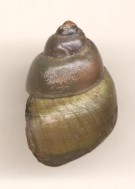
Viviparus crawshayi E. A. Smith, 1893
Zaire, Africa
Viviparus mweruensis E. A. Smith, 1893,
Lake Moero, Central Africa. Shell has growth line
features in common with Neothauma tanganyicensis,
above, and "Neothauma differs primarily from
Viviparus in th shape of the outer lip" (Pilsbry and
Bequaert, 1927).Bellamya jeffreysii
Frauenfeld, Central AfricaBellamya unicolor
Livier, 1806. Senegal
Australia
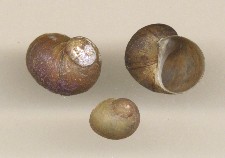
Larina strangei Adams 1854. Queensland, Australia.Hugh Jones of the New South Wales Department of Land & Water Conservation indicates that some of the Viviparidae are endangered in Australia. In particular, Notopala hanleyi and Notopala sublineata from the Murray-Darling drainage. These were thought to be extinct, but a few remnant populations have been rediscovered in irrigation pipelines. They were apparently a problem and the last known population of N. hanleyi may have been eradicated by efforts to clear the pipeline.
North America
Campeloma limum (Anthony,
1860), creeks and rivers of the
southern Atlantic coastal plain. x 2.
Campeloma decisum (Say,
1817) Eastern United states and
southern Canada generally;
rivers and lakes.
Relatively high-spired Campeloma from the
Cache River in Arkansas.
Lioplax sulculosa (Menke, 1828) American
mid south, larger rivers and reservoirs.
Viviparus georgianus
(Lea, 1834), southeastern
North America, apparently
invasivein Lake Champlain,
New Your.Viviparus subpurpureus
(Say, 1829), southeastern
North Anerica.Viviparus intertextus
(Say, 1829), southeastern
North America
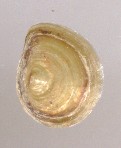
Viviparid opercula are concentrially structured
and assymetrical. Shown are Viviparus
subpurpureus (left) and V. intertextus (right).